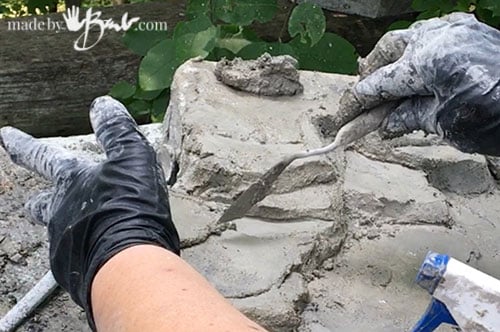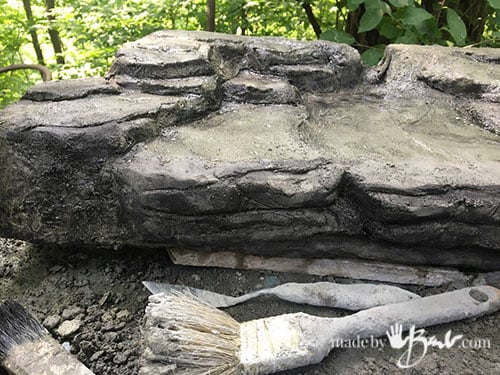Lightweight Concrete Faux Rock

What do you do when you can’t lift those heavy rocks but you want ‘big’ rocks? You knew I was going to say; ‘make them’! Here’s how to make your own Lightweight Concrete faux Rock.

When you get a ‘new’ TV:
When you get a new appliance and look at that mountain of styrofoam; there must be something I can do with it?! I heave been saving it for a while… and hubby was bugging me to get rid of it, soooo…
I like large rocks; diamonds and the like, the bigger – the better. I know rocks are cumbersome and back-breaking, so light weight ones are a dream. That’s when my problem-solver brain brought a few methods together.

I wanted to keep this as simple as possible. I did not want to fight with that chicken wire that always seems to poke & hook my skin. Simple – just attach a random shape of pieces of styrofoam. Wear gloves so you won’t be sticking to everything. I did not break many pieces as I hate the way it starts to cling and get everywhere.

Styrofoam does not absorb water, It’s light and pretty sturdy as well; so perfect as a form. Many glues will dissolve the styrofoam, so I found a can of ‘Great Stuff’ (as I was also incidentally also doing some window trim repair) It works well to attach the styrofoam as it quickly starts to set and also fills gaps. I was not fussy at all, just stuck random pieces together since I do not like the round rocks; I much prefer rocks with angles, textures and layers. There is another step for more detail so this is just a basic starting shape.

I was amazed at how quickly they all came together. I had 3 big bags full of pieces!
Base forms made!

These range about 18″ to 30″ in size. It’s ok to have a bit of flat sides as natures rocks often break off in layers as well.

Messy hands time!
I have used draping of concrete soaked fabric for a few projects now. The (famous) Spook, The Faux Bois Chair, the Cat and even the Rope Orbs all have some part of this method. So I realized that it would make for a great way to get a base shape, a stiff concrete skin.
My favourite way is to use only portland cement as it gets really smooth and can absorb well into fibres. Since I have a lot of used flannel from Eco printing, I found that it works well. It is a bit thinner but nicley absorbent. No problem to have extra layers or wrinkles either.

To make it less messy (a bit) I used smaller pieces, not really sized at all. ‘Think of it like paper-maché, layer and smooth out.
I found trying to wrap all the way around was a problem, as it would fall off. So I only did the tops and sides and then let cure. Remember, do not let it dry out too fast. Misting with water does not hurt, it helps.

I know they look strange, bit it’s just a base shape… you can be fussier if you like but usually the more contrived then the less it looks like nature..

Once the tops and sides are cured (usually overnight) you can wrap the bottom and even up the sides if it’s weak. There will be another layer so a few weak spots are not really an issue. It all depends also where you plan to put these. Mine are going to make a waterfall structure, not be climbed on. If you want them pretty indestructible, add more layers of the cement soaked fabric. If you choose thicker fabric it tends to get stiffer since more cement is impregnated, but also uses more mix. See my tests here.

These still look a bit boxy but looking pretty good considering how easy they were so far!

Some simple Tools:
To make some rock-like texture some simple tools can be used. An old brush dipped in a bit of fast setting cement or whatever else can make some good pebbly divots. Knives, like putty or pallet knives help spread the next layer, trowels help apply as well.
When adding any new concrete to existing it needs to be wetted, and if you want extra reassurance a bonding layer with a Bonding Agent can be painted on. I generally don’t use it bit did try for a couple to compare in the future.

The Second Concrete Layer
To make the texture and detail layer is made with Rapidset Mortar Mix. I have used their other product for many things so I trusted this one as well. It feels sandier than the Rapidset Cementall which makes better texture for rocks! BEWARE – it does set really fast! So use small quantities.
Add handfulls, some lumps, some divots, some crack lines… Dab with brush for texture. If needed google images of rocks. If you overthink it, they look more contrived.


Even corners are ok, as quarry stone is broken in big blocks.
The palette knife lets you form the concrete like icing a cake. These rocks will become a waterfall so the top layer was to be more like split layered rock. It’s quite fun to make random ledges, cut some cracks and roughen the edges. HOWEVER, do not get too much small detail! You will notice that small detail generally gets lost from a distance.
As it starts to set it can be carved into to make crisp cracks or crumbly edges.
The Question about Colour

As an illustrator I know that rocks are not just grey. They have many undertone colours. It also depends where your rocks will be, are they going with other natural rocks? Even some areas have different tendencies of colour. I knew I may need some adjustment later on (it’s the artist in me) but for now I added some black concrete colour watered down and worked into the areas that would naturally get darker. Vertical areas usually get darker as well as cracks. It is tricky since it will dry different later.

Keep things damp; the spray bottle handy – it allows the colour to flow naturally into crevices.

You can mix some of the concrete colour into some of the mix as well and spread on. Colours changes are usually not that pronounced, they look more like ‘dirty’ parts of rocks. I bet there will be some natural darkening as mossy areas will develop from being in a woodland setting

Texture is one of the most convincing parts of a rock. Don’t make it look like an ‘iced cake’

Stay tuned to see how the waterfall all came together! There’s also a bit of a surprise since it’s the habitat for a certain ‘friend’ of mine…
Love it!!! Love it!!! I am going to do it! Thank you SO much
Go for it! It’s fun.
What has been your experience with the WEIGHT of the faux rock and the concrete textiles? I have a 2:1 silty slope.
Mine are pretty light but I did secure them with a bonding glue for my waterfall. They have not really moved…
You are the sunshine on rainy Mondays. Just wanted to give you a shout out. I look forward to all your posts and projects. Big rocks are in my future – to give the landscaping some different heights and textures. I was going to use trash bags filled with recycled plastic. My concern was getting the cement to adhere to the outer plastic bag. By using your method of fabric – I’m thinking it may work if I let the top ‘drape’ harden overnight. Then create a large ‘under’ fabric soaked in cement. My thinking is that if i set the ‘overnight’ boulder on top of the new soaked fabric; I should be able to bring the sides up and mesh into the dried top layer.
No matter what – I’ll have a great time trying. You are an artistic bundle of joy and I look forward to all of your projects!!! Thank you for sharing your talents!!!
I think you have a good idea! Yes, you can adhere more, just make sure to wet the older concrete. My rocks have been handling the weather quite well. The only thing I thought of last year was I wonder how well it would hold a deer hoof! I have deer who come in the winter but so far they do not climb on the faux rocks, whew!
Looks amazing!! I’m building a faux rock mobile shop right now, 15’ long, so I’m trying to utilize as many free material for the form as possible, I.e, styrofoam chunks and big stuff! I still don’t know what to coat them with since it needs to be lightweight and road worthy but the fabric dipped concrete does give a really convincing look!
Yes! if you use multiple layers of thinner fabric it may still be light. There is also a mix that some people make with latex paint and joint compound. I have not tried it but if not exposed to the elements it may be good. I love figuring things out! Great for the brain!
Hi Barb,
I’m planning on making exactly what you showed here, but for a tiny strip of wall inside my house, Where an action man figure will rappel down the rock to function as a door closing mechanism. Wonderful work you did here!
question: when you mention Black concrete colour, do you mean the paint used to paint over concrete that has already set?
or do you mean the pigment that people add to make actual black concrete.
thanks so much!
If you add the pigment it makes the concrete darker. If it is for indoors, acrylic colour would do a good job to colour it to look natural. Keep the colouring thin and subtle. Have fun!
What a great idea. Thanks so much for this article.
Enjoy! They have held up quite nicely even though they get a wide variety of weather here in Canada! Check out other ways of using this method; Happy concreting!